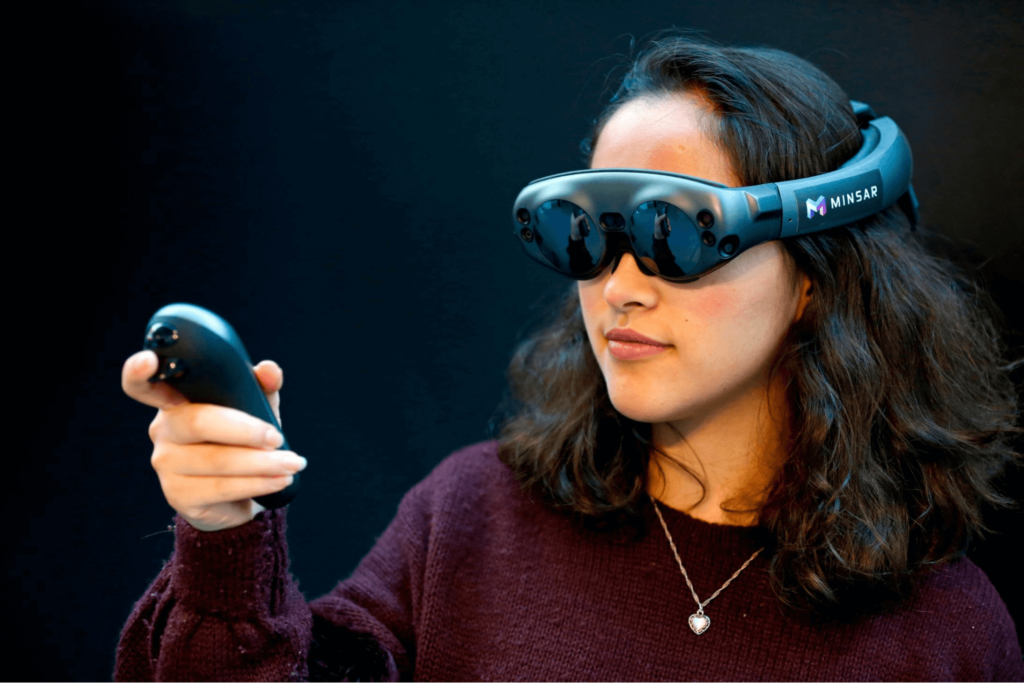Augmented Reality (AR) is a fascinating advancement in the field of Technology that blends digital elements with the real world in real-time. It enhances the user’s perception of reality by overlaying computer-generated content such as images, sounds, or information onto their surroundings through devices like smartphones or AR glasses.
Definition : Augmented Reality (AR) is a technology that enhances the real world by integrating digital information – such as images, sounds, and other sensory stimuli—into a user’s environment in real time.
This integration allows users to experience a richer interaction with their surroundings as digital content overlays the physical world.
Features of Augmented Reality (AR)
- Real-Time Processing: Instant display of digital content based on the user’s environment and interactions.
- Blends Real and Virtual Worlds: AR overlays virtual objects on the physical environment, unlike Virtual Reality (VR), which creates a fully virtual world.
- Requires a Display Device: Such as smartphones, tablets, or specialized AR devices like Microsoft HoloLens or Magic Leap.
- Spatial Awareness: AR systems have the ability to understand and interpret the real-world environment.
- Interactive Experiences: Users can interact with both real and virtual worlds (via touch, voice, gestures).
- Multi-Sensory Integration: AR can involve more than just visuals. It can integrate sounds, haptic feedback, and even smell or touch (in advanced implementations), creating a more immersive, multi-sensory experience.
- User-Centered Customization: Adapts content to user’s preferences and environment.
- 3D Visualization→ 3D virtual objects overlaid on real-world scenes.
Key Components of Augmented Reality (AR)
Hardware Components
- Cameras → Capture real-world data (images, position, movement).
- Sensors: These include accelerometers, gyroscopes, and magnetometers, which track the orientation, position, and movement of the AR device (e.g., smartphone, glasses).
- Depth Sensors (e.g., LiDAR): Measure the distance between objects, enhancing spatial awareness and object placement.
- GPS: Provides location-based data, especially for outdoor AR experiences.
- Processors → Handle data processing and render AR content.
- Central processing unit (CPU) is responsible for processing the captured data.
- Graphics processing unit (GPU) helps to render complex 3D graphics smoothly in real-time.
- Displays → Show AR content on devices (smartphones, AR glasses, HUD).
- Smartphones/Tablets: using the device’s screen to overlay digital objects onto the camera feed.
- AR Glasses/Headsets: Wearable devices (e.g., Microsoft HoloLens, Magic Leap) that provide a more immersive AR experience.
- Head-Up Displays (HUD): Used in vehicles or aviation. These displays project information onto a windshield or visor.

Software Components
- AR Software Development Kits (SDKs) → AR development tools (ARKit, ARCore, Vuforia).
- ARKit (Apple): For iOS devices.
- ARCore (Google): For Android devices.
- Vuforia: Cross-platform AR development tool.
- Unity/Unreal Engine: Game development platforms.
- Tracking & Mapping Algorithms → Track environment, place virtual content (SLAM, marker-based/markerless tracking).
- Simultaneous Localization and Mapping (SLAM): Helps AR devices map and track the environment in real-time, adjusting digital elements’ placement accurately.
- Marker-based tracking: Uses specific visual markers (QR codes, barcodes, or images) to trigger AR content.
- Markerless tracking: Utilizes sensors and the environment itself (without predefined markers) to track the space and place virtual objects.
- Image Recognition & Computer Vision → Detect and interpret real-world objects (object/facial recognition).
- Computer Vision → Recognizes and interprets the real-world environment using cameras and sensors. It enables AR devices to detect objects, faces, and features for accurate placement of virtual content.
Interaction Components
- User Interface (UI) → Touch, gestures, or voice for user control.
- Feedback Mechanisms → Haptic and audio feedback enhance interaction.
Connectivity & Data Processing
- Internet Connectivity → Cloud computing, Wi-Fi/5G for seamless data exchange.
- Data Analytics & Machine Learning → Improve AR precision and user interaction.
How AR Works →Basic Workflow:
- Input: Sensors and cameras capture the real-world environment.
- Processing: Software analyzes the environment and creates digital overlays.
- Output: Displays project digital content seamlessly into the real-world view.
Difference Between AR, VR, and MR:
- Augmented Reality (AR):
- Real World + Digital Content
- AR adds digital elements to a live view of the real world, enhancing the user’s environment with interactive, computer-generated content.
- Example: Viewing a virtual furniture model in your living room via your smartphone.
- Virtual Reality (VR):
- Entirely Virtual Environment
- VR creates a completely immersive, virtual world that disconnects the user from the real world. It is typically experienced through VR headsets that block out external surroundings.
- Example: Immersing yourself in a 3D video game or virtual tour using a VR headset.
- Mixed Reality (MR):
- Real World + Interactive Digital Content
- MR combines elements of both AR and VR, allowing for interactions with both real and virtual objects in real-time. The user can interact with and manipulate virtual objects in the real world.
- Example: Using a Microsoft HoloLens to interact with virtual objects while still being aware of and interacting with the real world around you.
Difference among AR, VR and MR
| Feature | Augmented Reality (AR) | Virtual Reality (VR) | Mixed Reality (MR) |
| Definition | Enhances the real world by overlaying digital elements. | Places the user in a different virtual environment using computer-generated simulation. | Combines AR and VR to integrate real and virtual worlds interactively. |
| Real-World Interaction | Extensive; users engage with the real world alongside digital content | Limited or none; users are in a virtual world | Extensive; users interact with both virtual and real-world elements |
| Devices | Smartphones, tablets, AR glasses (e.g., HoloLens). | VR headsets (e.g., Oculus Rift, HTC Vive). | Advanced AR/VR headsets (e.g., Microsoft HoloLens 2). |
| Level of Immersion | Partial immersion, maintains connection to the real world | Fully immersive, often isolating | Varied levels of immersion, offering both fully immersive and partial experiences |
| Real-Time Updates | Works with real-world environments in real-time. | Does not update with the real world, as it is completely simulated. | Adapts to both real and virtual elements in real-time. |
| Technology Dependency | Requires a camera and sensors to overlay virtual content. | Requires high computational power to create an immersive environment. | Requires advanced spatial mapping and interaction technologies. |
| Applications | Navigation (Google AR Maps), retail (virtual furniture placement). | Gaming (Beat Saber, VRChat), virtual training (flight simulators). | Healthcare (surgical simulations), industrial training, and collaborative design. |
| Cost | Relatively lower cost (smartphones, basic AR glasses). | Moderate to high cost (VR headsets, VR PCs). | Higher cost due to advanced hardware and software requirements. |
| Focus | Enhancing the real world. | Immersing in a completely digital world. | Merging real and virtual worlds for interaction. |
| Examples | Pokémon GO, Snapchat filters, Lenskart AR eyeglasses, flipkart 360 degree | Oculus Rift, HTC Vive, PlayStation VR | Microsoft HoloLens, Magic Leap |
Applications of Augmented Reality (AR)
| Sector | Applications | Examples (India) |
| Education & Training | Interactive Learning → AR apps make learning engaging (e.g., anatomy visualization, virtual labs). Skill Development → Training pilots, surgeons, or technicians using AR simulations. | IIT Madras Researchers are developing AR/VR (Augmented reality/Virtual Reality)-based enabled learning for schools in rural areas. |
| Healthcare | Surgical Assistance → AR overlays guide surgeons during procedures (e.g., veins mapping). Medical Training → Students visualize anatomy and practice surgeries | MediSim VR for AR-based medical training in India. |
| Retail & ECommerce | Virtual Try-Ons → Customers try clothes, makeup, or furniture virtually. Enhanced Shopping → Product information overlays in physical stores. | Lenskart (virtual eyewear try-on), CaratLane(jewelry try-on). |
| Gaming & Entertainment | Immersive Gaming → Immersive AR-based games integrating real-world environments. Live Events → AR enhances concerts, sports events, and theme park experiences. | Pokémon GO and local AR-based games like Tricolour AR. |
| Tourism & Navigation | Real-time navigation with AR maps showing directions and landmarks. Virtual Tours → Virtual heritage tours showcasing historical monuments. | Google AR Maps in Indian cities like Delhi and Mumbai.- ASI’s AR tours of Indian monuments like the Taj Mahal. |
| Manufacturing & Maintenance | Assembly Guidance → AR shows step-by-step instructions for machinery assembly. Equipment Maintenance → Technicians view repair instructions in real-time. | Tata Motors uses AR for automobile assembly and maintenance training. |
| Military & Defense | Simulations → AR-based combat training and virtual battlefields. Helmet Displays → Real-time battlefield data for soldiers (e.g., enemy location). | Indian Army’s AR combat drills for better soldier preparation. |
| Architecture & Real Estate | 3D Models → Visualize buildings and interiors before construction. Virtual Property Tours → Buyers explore properties using AR apps. | Makaan App for virtual property tours and AR-based real estate visualization. |
| Media & Advertising | Interactive Ads → AR campaigns engage customers with 3D visuals (e.g., AR billboards). Brand Engagement → AR filters on social media promote brands. | Snapchat AR Filters for Indian brands. |
| Agriculture | Crop Monitoring → AR drones analyze plant health and growth. | KrishiMantra AR Solutions for Indian farmers. |
| Sports | Player Stats → Real-time overlays during live matches. Training Tools → Analyze player performance and simulate real-world scenarios. | Hotstar AR enhancing IPL cricket match viewing experience. |
AR in India
Market: The AR market in India is projected to grow significantly, with a compound annual growth rate (CAGR) of over 55% from 2023 to 2026. This growth is driven by increased awareness and adoption of AR technologies across multiple sectors.
Government Initiatives:
- Centre of Excellence on Virtual & Augmented Reality (VARCoE): Set up at IIT Bhubaneswar by Software Technology Parks of India to promote AR/VR research and collaboration.
- Digital India & Make in India: Encourage the growth of AR/VR technologies by fostering innovation and manufacturing.
- XR Startup Program:
- Goal: Foster XR startups in Augmented Reality (AR) and Virtual Reality (VR).
- Initiative by: MeitY Startup Hub (MSH), Ministry of Electronics & IT (MeitY), and Meta.
- Target Startups: Early-stage XR startups, especially from Tier 2/3 cities.
- Program Structure:
- Accelerator Program: Supports 40 startups with ₹20 lakh grants for XR technology development.
- Grand Challenge: Shortlists 80 innovators, with 16 receiving ₹20 lakh grants for MVPs/prototypes in sectors like Education, Healthcare, Gaming, Agritech, etc.
- IIT Madras XR Summit: Hosted India’s first Academia-Industry supported ‘eXtended Reality’ (XR) Summit.
Industry Collaborations:
- WAVES Summit (Nov 2024): Ministry of Information and Broadcasting partners with Wavelaps to elevate India’s AR/VR ecosystem.
- VRARA India Chapter: Established in cities like Ahmedabad, Bangalore, and Mumbai to connect AR/VR professionals.
Educational and Research Developments:
- e-Pathshala AR App: NCERT app enhances textbooks with AR for more interactive learning.
- IIT Jodhpur’s AR/VR Program: Offers a Master’s in Design (MDes) in AR/VR to train students for the immersive tech sector.
- IIT Madras AR/VR Learning for Rural Schools: Researchers at IIT Madras are developing AR/VR-based learning tools for schools in rural areas.
Private Sector Innovations:
- Memesys Culture Lab: Founded by Anand Gandhi and leading VR journalism in India by creating immersive documentaries.
Defense:
- Augmented Reality Head Mounted Display (ARHMD) System for Indian Army: Provides radar and thermal imaging overlays for improved engagement during night, bad weather, and daytime operations.
